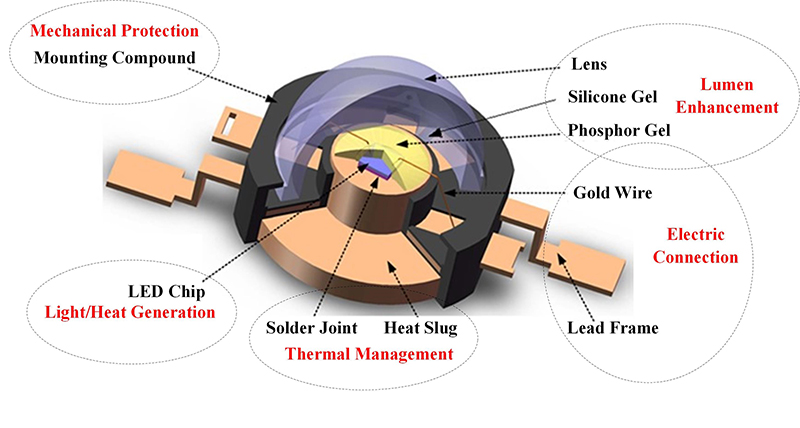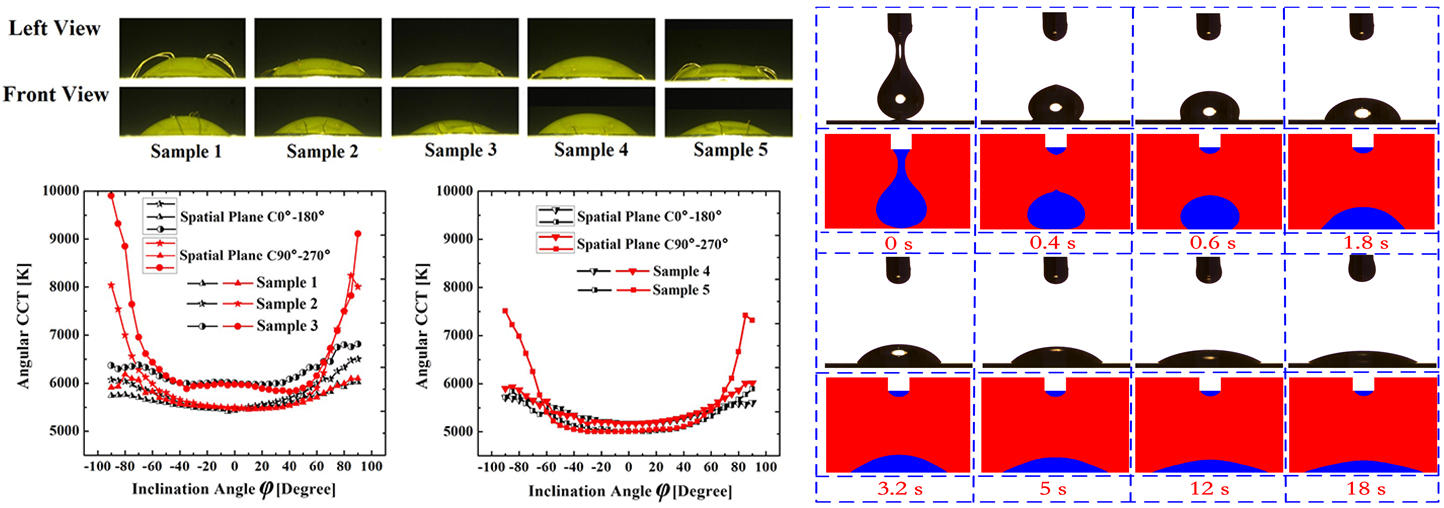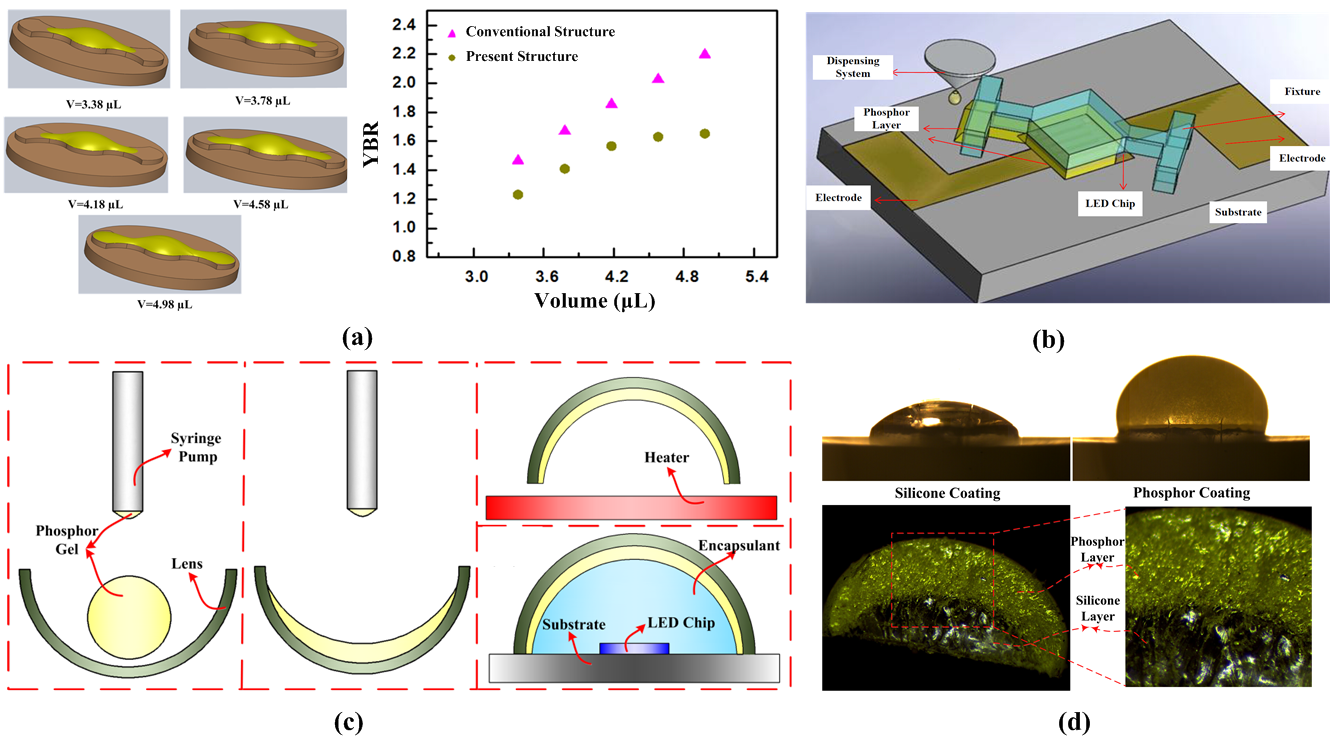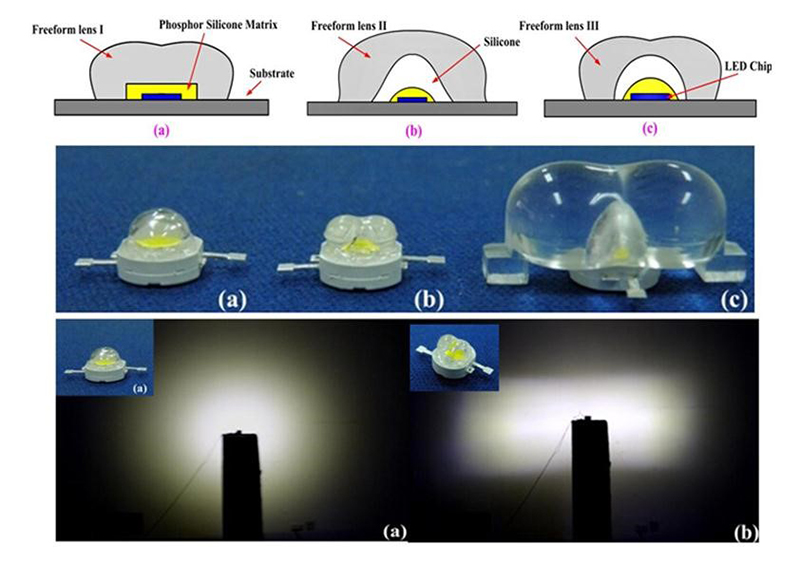LED Packaging and Application
LED, as a green lighting source, has been considered as the fourth-generation light source in the 21st century. Fig.1 shows the schematic of the most-popular in market high-power leadframe LED package and the functions of each part: 1) electric interconnection; 2) mechanical protection; 3) heat dissipation; 4) high-efficiency and high-quality lighting.
We are doing research on LED packaging and applications, and the related achievements are as follows: 1) packaging processes optimization design; 2) heat dissipation and optical-thermal coupling study; 3) optical designs for many complicated applications; 3) quantum-dot LED packaging.

Fig.1 Common high power LED with lead frame and functions of each component
1. Optimization design for packaging processes
Accurate modeling that realizes precise prediction of LED lighting and study on the effect of packaging parameters on lighting, like phosphor morphology, wire bonding process, etc. (see Fig. 2).
Realizing the coating process in real time based on the flowing characteristics in order to control the coating morphology and realize the user-demanded optical performances (color rendering index, space color uniformity, color temperature, luminous efficiency, etc.) (see Fig. 3).
Predicting and control of packaging processes, especially for some key process that influence the optical/thermal performances greatly, like die bonding, phosphor sedimentation, etc. (see Figs. 4 and 5).
Proposing many novel phosphor coating processes to control the phosphor morphology effectively (see Fig. 6).

Fig.2 Influence of wire bonding process on the optical performance of LEDs Fig. 3 Phosphor geometry evolution with time during the spreading process

Fig.4 LED chip self-alignment technology Fig. 5 Phosphor sedimentation prediction model

Fig. 6 (a) Phosphor layer geometry control based on minimum free energy;(b) Conformal phosphor coating using capillary microchannel;(c) Remote phosphor coating based on lens wetting;(d) Thermal remote phosphor coating
 2. Heat dissipation, optical-thermal coupling and reliability study
2. Heat dissipation, optical-thermal coupling and reliability study
During the working of LEDs, about 70% of the input electrical power is converted into heat and most of them is generated in the small-scale chips. Heat is conducted through chips, die attach layer, thermal interfacial materials, heat substrate and heat sink, thus the heat dissipation problem for LEDs involves with the challenges of high-density heat flux, multiple scales, multiple materials, multiple interfaces, etc.
We design for the LED heat dissipation from the perspectives of structure, material, and process, and the achievements are as follows. 1) Establishing thermal resistance network model for LEDs to predict the junction temperature accurately (see Fig. 7); 2) Establishing the optical-thermal coupling model for phosphors to direct the design of LED packaging processes to enhance light extraction and confine heat generation (see Fig.8). 3) Designing for high-performance heat sink, including fin, microchannel, microjet, etc. (see Fig. 9). 4) Online evaluation of reliability, including the precise evaluation of lifetime and reliability of LED packages and applications (see Fig. 10).

Fig. 7 Thermal resistance network model for LEDs Fig. 8 Optical-thermal coupling model for phosphors

Fig. 9 Microjet array colling system Fig. 10 Online reliability evaluation platform
3. Optical design
High efficiency, controlling ability of the lighting pattern, and high angular color uniformity are the three indispensable and key factors to realize high quality LED lighting. Optical design is essential step to realize such high performances. 1) Proposing a general non-optics lens-design algorithm to realize any energy-mapping (see Fig. 11); 2) Developing the lens-design software that can be applied for LED spotlight, flashlight, and street lights (see Fig. 12); 3) Designing LED headlamp, large-size backlighting unit, street lamp, tunnel light, landscape light, spotlight, in-door lighting, etc. with lots of applications (see Fig. 13).

Fig. 11 Energy-mapping model for lens designing Fig. 12 Lens-design software

Fig. 13 Self-design LED street lamp and its application
4. Quantum-dot LED packaging
Quantum-dots are a kind of emerging photoluminescent materials, which possess many advantages of broad color gamut, size-dependent emission spectrum, high color rending ability, etc. QD-LED packaging is the development trend of future LED packaging, and the achievements of TPL are as follows. 1) Proposing packaging processes and material fabrication methods for high-performance QD-LEDs; 2) Revealing the coupling relationship between the optical and thermal performances of QE-LEDs (see Figs. 14 and 15).

Fig. 14 Quantum Dot and its thermal performannce Fig. 15 Optical performance of Quantum Dot



